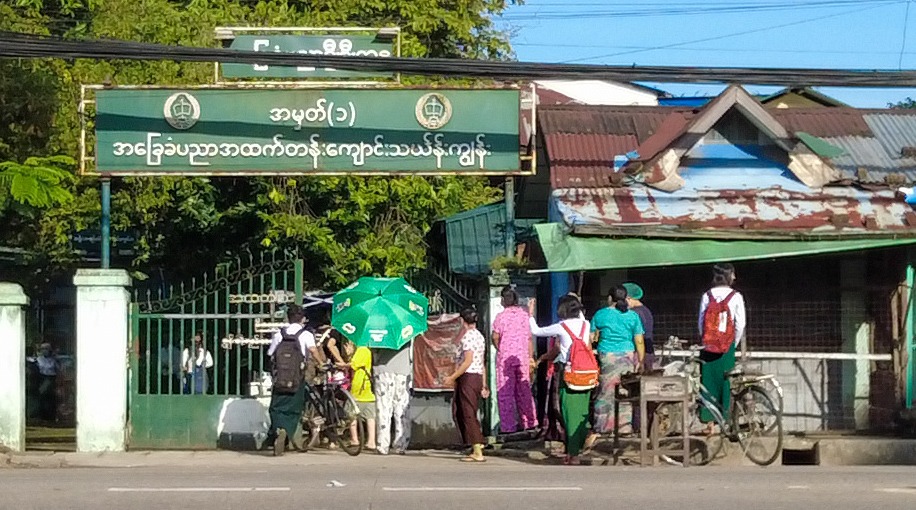After claiming to have met its ambitious targets for the curtailing of COVID-19 positivity rates, the junta has ordered yet another return to the classroom. On November 1, schools reopened in all except 46 townships of Burma. However, with soldiers remaining in campuses and teachers firmly holding the CDM line, reports on the ground suggest that few families have taken note of the dictat.
In what appears to be a comprehensive continuation of a nationwide boycott of schooling under the junta, local media reports suggest that school attendances may have fallen to even lower levels than those seen after the short-lived mandated opening in June.
As is customary, junta mouthpieces such as the Myawaddy television channel reported that state schools, private schools and monastic schools had reopened peacefully across all regions. No mention was made of the rate of returning students, but footage was shown of classrooms operating to capacity, guarded by the country’s benevolent security forces and other brave citizens alert to the dangers of the PDF.
The reality was of course rather different. In Yangon, local sources throughout the town reported that, for every state school, only a handful of teachers and students returned for the new term. One resident of Thingangyun told DVB that around two or three teachers showed up for each primary school in the township, and were met by a half a dozen or so students. A mother who spoke to us said that she would be waiting for a couple of weeks to gauge the situation. If it is “stable”, she says, her son will resume classes.
Parents’ fears are based on the military’s long-term camping of educational campuses across the country. During the brief return to schools in June, there were a number of reports of soldiers—who were present both at the school gates and within classes—harassing young children, in some cases sexually.
Furthermore, in the months since July, bombings of state buildings have intensified significantly—a fact that the military has happily coopted to justify its continued occupation of school buildings. Parents of course cited these security risks amongst their highest concerns. Despite the military claiming a victory against COVID-19, realities on the ground also leave families questioning the safety of their children whilst virus case numbers remain significant.
A comprehensive scan of local media reports understandably suggest that reopenings have been less prevalent in areas where fighting between PDFs and the military are intensifying; in particular, in regions of central and upper Burma, Chin and Kayah States, and in Tanintharyi region.
BBC Burmese reported that almost all schools remained closed in Htigyaing, Sagaing Region, a town at the forefront of the military’s campaign of violence. Reports suggested that a number of schools did reopen in nearby Pale and Yinmarbin townships, but locals have said that student and teacher numbers are extremely low, and have declined since the military intensified its offensive against the region. Similarly, in Magway, sources told DVB that schools across two villages of Yesagyo township were desolate.
In lower Burma, local media reported that the number of students returning to schools in Ayeyarwady Region was also low: despite almost every state school reopening with the oversight of a plethora of armed guards, student numbers are reported to have declined. In Bogalay, a primary school which previously registered 200 children was reportedly empty—not a single teacher or student was present on Monday. In Yeki, reports suggested that only around one percent of all students returned.
The Kachin Information Center told a similar story for Kayin State. A handful of students were reported to have returned to schools in Tanai township, according to other local media sources. In Mon State, 40,000 students attended state schools on Monday despite 400,000 being registered, an official from the Mon State Education Department told the Than Lwin Times.
One outlier to the trend was Rakhine State, where, since the coup, the United League of Arakan has made inroads into establishing an autonomous civil service. Local media reports suggest that, apart from the rural southern township of Gwa (on the border of increasingly volatile Ayeyarwady Region), school turnout was high. All schools were said to have successfully reopened in the capital of Sittwe. Rakhine’s high return rates were further helped by the fact that, due to the ULA’s increasing autonomy, Sittwe’s health authorities have managed to vaccinate a reported 70 percent of the town’s students.



